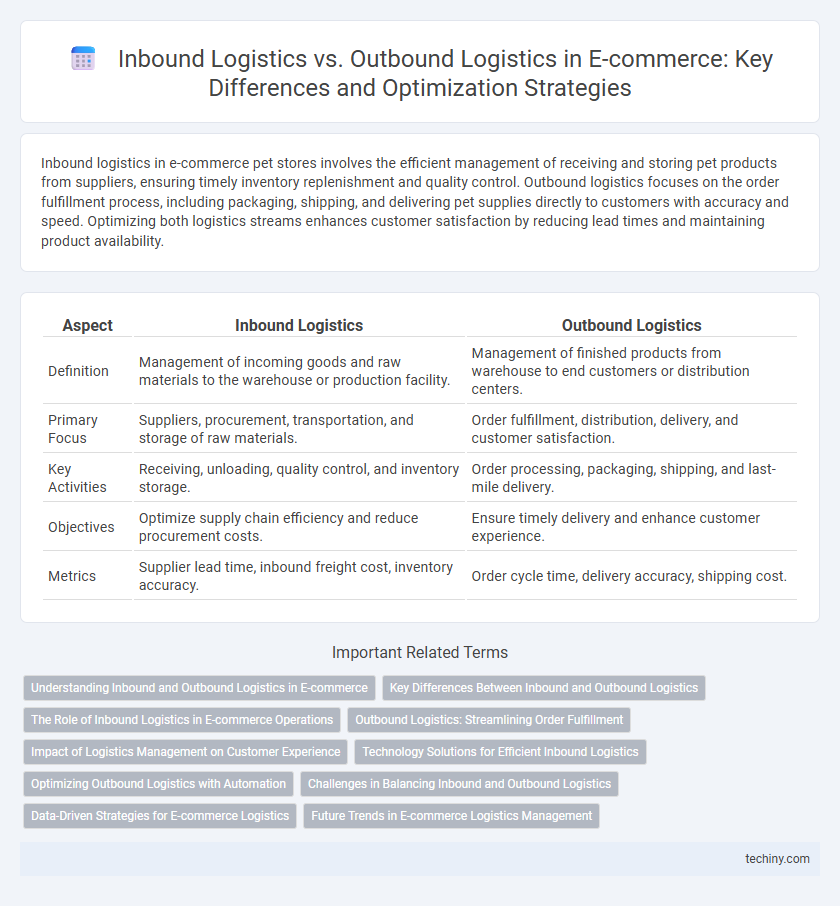Inbound logistics in e-commerce pet stores involves the efficient management of receiving and storing pet products from suppliers, ensuring timely inventory replenishment and quality control. Outbound logistics focuses on the order fulfillment process, including packaging, shipping, and delivering pet supplies directly to customers with accuracy and speed. Optimizing both logistics streams enhances customer satisfaction by reducing lead times and maintaining product availability.
Table of Comparison
| Aspect | Inbound Logistics | Outbound Logistics |
|---|---|---|
| Definition | Management of incoming goods and raw materials to the warehouse or production facility. | Management of finished products from warehouse to end customers or distribution centers. |
| Primary Focus | Suppliers, procurement, transportation, and storage of raw materials. | Order fulfillment, distribution, delivery, and customer satisfaction. |
| Key Activities | Receiving, unloading, quality control, and inventory storage. | Order processing, packaging, shipping, and last-mile delivery. |
| Objectives | Optimize supply chain efficiency and reduce procurement costs. | Ensure timely delivery and enhance customer experience. |
| Metrics | Supplier lead time, inbound freight cost, inventory accuracy. | Order cycle time, delivery accuracy, shipping cost. |
Understanding Inbound and Outbound Logistics in E-commerce
Inbound logistics in e-commerce involves the management of receiving, storing, and distributing raw materials or products from suppliers to warehouses, ensuring inventory accuracy and timely availability. Outbound logistics focuses on order fulfillment processes including picking, packing, shipping, and delivering products to customers efficiently. Optimizing both inbound and outbound logistics enhances supply chain visibility, reduces delivery times, and drives customer satisfaction in e-commerce operations.
Key Differences Between Inbound and Outbound Logistics
Inbound logistics in e-commerce involves the receipt, storage, and management of raw materials or products from suppliers, ensuring inventory is available for order fulfillment. Outbound logistics focuses on the distribution process, managing order processing, packaging, and shipping of finished goods to customers. Key differences include the direction of goods flow, with inbound handling incoming supplies and outbound managing delivery, as well as distinct operational priorities like supplier coordination versus customer satisfaction.
The Role of Inbound Logistics in E-commerce Operations
Inbound logistics in e-commerce involves the efficient management of receiving, storing, and handling raw materials or products from suppliers to warehouses, directly impacting inventory accuracy and order fulfillment speed. Optimizing inbound logistics reduces lead times, minimizes stockouts, and enhances supply chain transparency, crucial for maintaining competitive delivery times and customer satisfaction. Advanced technologies like real-time tracking and automated inventory systems streamline inbound processes, supporting seamless operations and cost-effective inventory management.
Outbound Logistics: Streamlining Order Fulfillment
Outbound logistics plays a critical role in e-commerce by ensuring efficient order fulfillment, including picking, packing, and shipping products directly to customers. Optimizing outbound processes reduces delivery times and enhances customer satisfaction, leveraging advanced warehouse management systems (WMS) and real-time tracking technologies. Integrating outbound logistics with customer demand forecasting and inventory management improves accuracy and scalability in order fulfillment operations.
Impact of Logistics Management on Customer Experience
Efficient inbound logistics ensures timely procurement and inventory availability, directly influencing product readiness and reducing stockouts, which enhances customer satisfaction. Effective outbound logistics optimizes order fulfillment speed and accuracy, leading to faster deliveries and reliable shipping updates that improve overall customer trust and loyalty. Strategic management of both logistics phases minimizes delays and errors, creating a seamless e-commerce experience that drives repeat purchases and positive reviews.
Technology Solutions for Efficient Inbound Logistics
Technology solutions for efficient inbound logistics in e-commerce leverage advanced inventory management systems, real-time tracking, and automated warehouse operations to streamline the receipt and storage of goods. Integration of Internet of Things (IoT) devices and AI-driven analytics enhances accuracy in demand forecasting and reduces delays in supply chain processes. Implementing robotics and blockchain technology further ensures transparency, minimizes errors, and accelerates the handling of inbound shipments.
Optimizing Outbound Logistics with Automation
Optimizing outbound logistics in e-commerce through automation significantly reduces shipping errors, accelerates order fulfillment, and enhances customer satisfaction. Automated systems streamline inventory management, packaging, and carrier selection, leading to cost savings and improved delivery times. Integrating real-time tracking and predictive analytics optimizes route planning and resource allocation, ultimately boosting operational efficiency.
Challenges in Balancing Inbound and Outbound Logistics
Balancing inbound and outbound logistics in e-commerce involves managing complex supply chain challenges such as synchronization of supplier deliveries with order fulfillment demands to avoid inventory bottlenecks or stockouts. Disparate lead times and fluctuating customer order volumes increase pressure on warehousing, requiring advanced forecasting and real-time inventory tracking systems. Ensuring seamless coordination between procurement processes, transportation scheduling, and last-mile delivery optimization remains critical for operational efficiency and customer satisfaction.
Data-Driven Strategies for E-commerce Logistics
Inbound logistics in e-commerce involves the efficient management of receiving, warehousing, and inventory control of products sourced from suppliers, using data-driven strategies such as real-time tracking and predictive analytics to optimize stock levels. Outbound logistics focuses on order fulfillment, packaging, and timely delivery to customers, leveraging data from customer behavior and transportation routes to enhance delivery speed and reduce costs. Integrating data analytics across both inbound and outbound logistics improves supply chain visibility, reduces operational inefficiencies, and drives customer satisfaction in e-commerce.
Future Trends in E-commerce Logistics Management
Future trends in e-commerce logistics management emphasize the integration of AI-driven inbound logistics to optimize inventory accuracy and warehouse efficiency. Automated sorting, real-time supply chain visibility, and predictive analytics enhance outbound logistics by enabling faster, flexible delivery options and improved last-mile fulfillment. Sustainable practices and blockchain technology are increasingly adopted to ensure transparency, reduce carbon footprints, and strengthen trust throughout both inbound and outbound logistics processes.
Inbound Logistics vs Outbound Logistics Infographic

 techiny.com
techiny.com